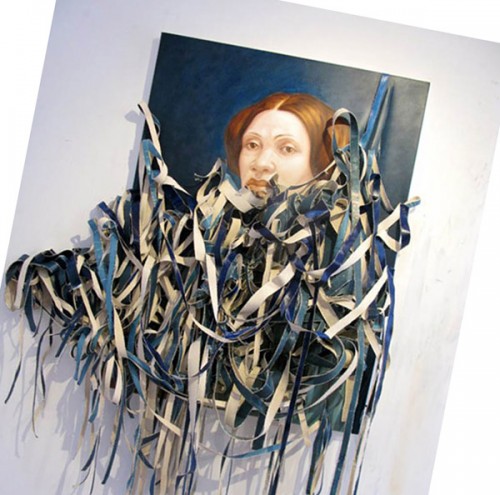 |
| Clara Lieu, “Self-Portrait No. 31″, from ”Falling“ |
Sometimes an artist puts everything into
a series of works of art. The artwork carries the essence of the person with it. An artist that does just that is the inspiration for our first project (it will be a difficult one). We are going to jump right in draw a self-portrait that has expression.
Clara Lieu an artist and Professor at Rhode Island School of Design created a series of expressionistic self-portraits that are executed so perfectly (if there is such a thing as a perfect work of art).
Take a look. In your sketchbook write your reaction to her self-portraits. Which one do you like the best and why? I also want you to look up some creative self-portraits and put the links of them in the comment area of this post.
The human face is universal, that is obvious, but drawing it a certain way is not. In this drawing lesson you will have many challenges, from drawing your facial features in proportion to developing a creative idea and composition. Ask yourself what you need to work on when it comes to drawing facial features.? Does the idea of drawing yourself make you excited or scared (or a little bit of both)? No worries, relax and take the steps needed to make your drawing YOURS. Planning, practicing, and being thoughtful about the process will help you be successful!
Steps to take:
· *Draw your features separately and as a whole face. Practice, Practice, Practice. This will count as a sketchbook grade.
· *View styles of self-portraits, including the ones on this hand-out. See how other artists have approached this idea. Take to the web and search for images of self-portraits. Share your favorite with the class.
· Design a composition that is interesting and that focuses on the mood you want to get across. There has be an identifiable mood (at least by you and hopefully the viewer). 3 different approaches of your ideas should be sketched for a grade.
· Do a gesture or contour drawing the actual size you plan on making your piece. No smaller than 12 x 18 will be acceptable.
· Work on drawing by building up values and focusing on each mark you make. This is a long-term project and you should take your time, enjoy the process.
· Complete a self-reflection in your sketchbook after the class critique. This important step allows your think about what you feel successful at what you need to work on.
|
As an outcome of this lesson you will:
· Generate and conceptualize a unique self-portrait that expresses a mood and/or expression that is personally meaningful. (NCAS Anchor Standard 1 and 2/Investigate, Plan, Make)
· Demonstrate skills and techniques in drawing (NCAS Anchor Standard 3/Reflect, Refine, Continue)
· Critique self and peer work (NCAS Anchor Standard 7/Perceive)
· Identify the characteristics of self-portraits by Frida Kahlo and Clara Lieu
Project Requirements:
· Sharing research and ideas with peers. Partaking in group discussions exploring various concepts with classmates. Sketchbook: Example of one self-portrait done by an artist that you find intriguing, to share with class.
· Three thumbnail sketches of alternate concepts for drawing.
· Completed drawing (see separate rubrics)
· Completed self-reflection
· Participating in final project critique.
Vocabulary: value, contrast, proportion, cropping, space, depth, texture, emphasis, craftsmanship, persistence
|
As an outcome of this lesson you will:
· Generate and conceptualize a unique self-portrait that expresses a mood and/or expression that is personally meaningful. (NCAS Anchor Standard 1 and 2/Investigate, Plan, Make)
· Demonstrate skills and techniques in drawing (NCAS Anchor Standard 3/Reflect, Refine, Continue)
· Critique self and peer work (NCAS Anchor Standard 7/Perceive)
· Identify the characteristics of self-portraits by Frida Kahlo and Clara Lieu
Project Requirements:
· Sharing research and ideas with peers. Partaking in group discussions exploring various concepts with classmates. Sketchbook: Example of one self-portrait done by an artist that you find intriguing, to share with class.
· Three thumbnail sketches of alternate concepts for drawing.
· Completed drawing (see separate rubrics)
· Completed self-reflection
· Participating in final project critique.










